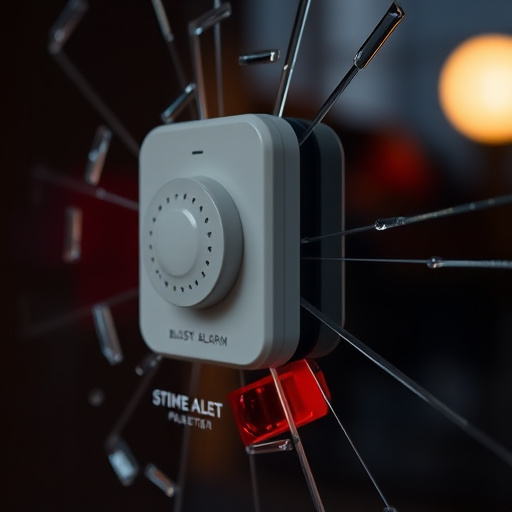Glass break alarm sensors, a specialized security solution, detect shattered glass' unique acoustic signature, providing immediate alerts for potential threats. Integrated into comprehensive systems, these sensors offer peace of mind by swiftly notifying occupants and security personnel. They are invaluable in high-risk areas like stores, schools, and homes with valuable items, enhancing security through early warnings and deterring burglars. Wired and wireless options cater to specific needs and installation constraints, with microphone or motion/impact technology ensuring optimal protection based on property layout and security goals.
“Discover the power of protection with Glass Break Alarm Sensors – essential tools in modern security. This comprehensive guide explores their vital role in safeguarding your space. From understanding sensor technology and its mechanics to examining benefits and different types, we delve into how these devices offer advanced protection against break-ins. Learn about wired vs wireless options and find the perfect fit for your property’s unique needs.”
Understanding Glass Break Alarm Sensors: Their Role in Security
Glass break alarm sensors play a pivotal role in enhancing home and business security by detecting the distinct sound patterns produced when glass is broken. Unlike traditional alarms that rely on motion or impact detectors, these sensors are specifically designed to recognize the unique acoustic signature of shattered glass, providing a swift and accurate response to potential threats.
When integrated into a comprehensive security system, glass break alarm sensors act as vigilant sentinels, offering peace of mind by alerting occupants and security personnel instantly upon detection of a break. This early warning mechanism is particularly valuable in high-risk areas, such as stores, schools, and homes with valuable items, enabling swift action to deter intruders or mitigate potential losses.
How Glass Break Sensors Work: Technology and Mechanics
Glass break sensors are designed to detect and respond to the unique acoustic signature of broken glass, providing an effective security measure for homes, businesses, and public spaces. These sensors work by utilizing advanced technology to analyze sound waves and identify the distinct pattern produced when glass is shattered.
The mechanism typically involves a microphone or sensor that captures ambient noise and focuses on specific frequencies associated with glass breakage. When a glass panel is broken, it creates a rapid series of high-frequency sounds. The sensor processes these acoustic signals, comparing them to pre-programmed patterns to determine if a genuine break has occurred. This instant detection triggers an alarm, alerting nearby occupants or security systems, thereby deterring potential intruders and ensuring prompt response to any unauthorized access attempts.
Benefits of Installing Glass Break Alarm Sensors
Installing a glass break alarm sensor offers numerous advantages for enhancing home or business security. These advanced devices are designed to detect and alert about any sudden breaks or shattering of glass, providing an immediate response to potential threats. The primary benefit lies in its ability to offer early warning, allowing occupants to take prompt action and ensure the safety of everyone inside.
Additionally, glass break sensors contribute to a comprehensive security system by monitoring vulnerable areas like windows and glass doors. They are particularly useful for preventing burglaries, as would-be intruders are deterred by the knowledge that any attempt at breaking glass will trigger an alarm. This technology provides peace of mind, knowing that your property is better protected against unauthorized access.
Types of Glass Break Sensors: Wired vs Wireless
Glass break alarm sensors come in two primary types: wired and wireless. Wired sensors are physically connected to a security system through a cable, offering reliable and consistent performance. They’re typically more secure as they require physical intervention to disconnect, providing an extra layer of protection against false alarms. On the other hand, wireless sensors operate independently using radio frequency (RF) or acoustic waves. This makes them easier to install, particularly in hard-to-reach areas or places where drilling is not feasible. Wireless sensors can also be more flexible and mobile, allowing for better coverage across a property.
Choosing between wired and wireless glass break alarm sensors depends on specific needs and constraints. For areas requiring robust security and minimal false alarm potential, wired sensors are often the preferred choice. In contrast, wireless sensors are ideal for retrofits, temporary setups, or scenarios where ease of installation and flexibility are paramount, such as in larger properties with multiple glass breaks.
Choosing the Right Glass Break Sensor for Your Property
When selecting a glass break alarm sensor, understanding your property’s unique needs is paramount. These sensors are designed to detect shattering or breaking glass, triggering an alarm to alert you and potential intruders. The right choice depends on factors like the size of your property, the type of windows, and specific security requirements. For instance, residential properties might opt for sensors that cover larger areas with a single alarm, while commercial buildings may require multiple, localized sensors for comprehensive protection.
Additionally, consider sensor technology: some models use micro-phone technology to pick up the distinct sound of glass breaking, while others employ motion or impact sensors. Each has its advantages; microphone sensors offer higher accuracy but might be affected by environmental noise, whereas motion/impact sensors are more reliable in noisy environments but can trigger false alarms with sudden movements. Selecting a sensor that aligns with your property’s layout and security goals ensures optimal protection and peace of mind.
